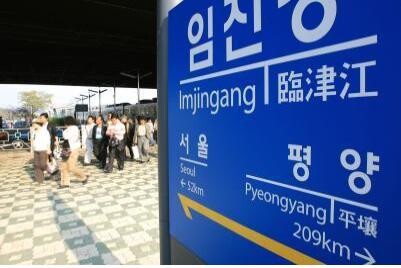hankyoreh
Links to other country sites 다른 나라 사이트 링크
Government announces plans to restore section of railway to North Korea

The central government has announced plans to restore the South Korean section of the Gyeongwon railway line between Seoul and Wonsan in North Korea.
Questions are now being raised about the purpose of the restoration at a time when the existing Gyeongui and Donghae lines between North and South remain unusable.
The plan was announced on June 28 by the Ministry of Land, Infrastructure and Transport (MLIT).
“We intend to start work in late July on restoring the 9.3-kilometer section of the South Korean Gyeongwon line between Baengmagoji and Woljeong Village [at the Southern Limit Line], where traffic has previously been halted,” the ministry explained.
The project will cost 129 billion won (US$115 million) from the Inter-Korean Cooperation Fund, with additional projects to connect Woljeong Village to the Military Demarcation Line (2.4 km) and from there to Pyonggang in North Korea (14.8 km) contingent on discussions with Pyongyang, the ministry added.
South Korea currently has rail service operating on its 94.4-km section between Yongsan and Baengmagoji, while North Korea is using the 104-km section between Pyonggang and Wonsan.
The MLTI explained that the Gyeongwon Line requires repairs and linkage with the North to form it into a Korean Peninsula railroad that connects in the future with the Trans-Siberian Railroad. Indeed, the linkage of the Gyeongwon Line and Trans-Siberian Railroad is one of the key projects in the Eurasia Initiative announced by President Park Geun-hye. The line would travel via Pyongyang to Wonsan, where it would then continue to Rajin before linking with the Trans-Siberian Railroad. A Keumgangsan branch line between Baengmagoji and Woljeong Village also connects with Naegumgang.
Following an agreement at a 2000 Inter-Korean Summit during the Kim Dae-jung presidency, the two Koreas opened the Gyeongui Line to Kaesong Industrial Complex during the Roh Moo-hyun administration in 2003, and the Donghae Line to Mt. Keumgang in 2006.
But both lines have remained out of service after relations with Pyongyang soured under the Lee Myung-bak administration, which began in 2008. The Gyeongui and Donghae Lines could connect with the Trans-China Railway, Trans-Mongolia Railway and the Trans-Siberian Railroad.
During a preliminary briefing on June 26, the MLTI sidestepped questions about the point of restoring the southern section when the existing Gyeongui and Donghae Lines to North Korea remain unusable.
“The issue of inter-Korean relations is outside the scope of the MLIT’s duties,” it said at the time.
By Kim Kyu-won, staff reporter
Please direct questions or comments to [english@hani.co.kr]

Editorial・opinion
![[Editorial] Yoon must halt procurement of SM-3 interceptor missiles [Editorial] Yoon must halt procurement of SM-3 interceptor missiles](https://flexible.img.hani.co.kr/flexible/normal/500/300/imgdb/child/2024/0501/17145495551605_1717145495195344.jpg) [Editorial] Yoon must halt procurement of SM-3 interceptor missiles
[Editorial] Yoon must halt procurement of SM-3 interceptor missiles![[Guest essay] Maybe Korea’s rapid population decline is an opportunity, not a crisis [Guest essay] Maybe Korea’s rapid population decline is an opportunity, not a crisis](https://flexible.img.hani.co.kr/flexible/normal/500/300/imgdb/original/2024/0430/9417144634983596.jpg) [Guest essay] Maybe Korea’s rapid population decline is an opportunity, not a crisis
[Guest essay] Maybe Korea’s rapid population decline is an opportunity, not a crisis- [Column] Can Yoon steer diplomacy with Russia, China back on track?
- [Column] Season 2 of special prosecutor probe may be coming to Korea soon
- [Column] Park Geun-hye déjà vu in Yoon Suk-yeol
- [Editorial] New weight of N. Korea’s nuclear threats makes dialogue all the more urgent
- [Guest essay] The real reason Korea’s new right wants to dub Rhee a founding father
- [Column] ‘Choson’: Is it time we start referring to N. Korea in its own terms?
- [Editorial] Japan’s rewriting of history with Korea has gone too far
- [Column] The president’s questionable capacity for dialogue
Most viewed articles
- 1Months and months of overdue wages are pushing migrant workers in Korea into debt
- 2At heart of West’s handwringing over Chinese ‘overcapacity,’ a battle to lead key future industries
- 3[Editorial] Yoon must halt procurement of SM-3 interceptor missiles
- 4Trump asks why US would defend Korea, hints at hiking Seoul’s defense cost burden
- 5Fruitless Yoon-Lee summit inflames partisan tensions in Korea
- 6Dermatology, plastic surgery drove record medical tourism to Korea in 2023
- 71 in 3 S. Korean security experts support nuclear armament, CSIS finds
- 8[Editorial] New weight of N. Korea’s nuclear threats makes dialogue all the more urgent
- 9First meeting between Yoon, Lee in 2 years ends without compromise or agreement
- 10Under conservative chief, Korea’s TRC brands teenage wartime massacre victims as traitors